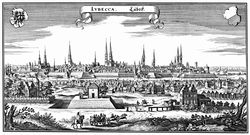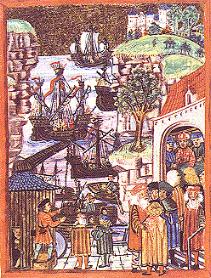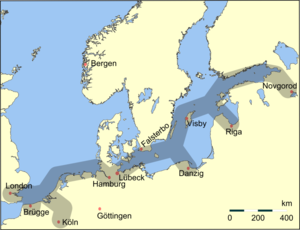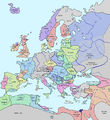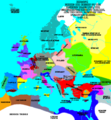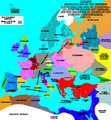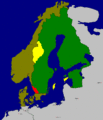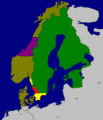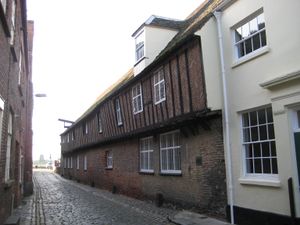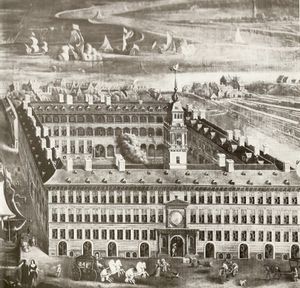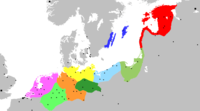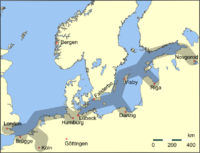الرابطة الهانزية
هانزه أو الرابطة الهانزِية (بالألمانية: die Hanse) هي رابطة ضمت العديد من المدن التجارية في منطقة بحر الشمال (شمال ألمانيا) و البلطيق، استمرت من القرن الـ12 حتى الـ17 م. ضمت في البداية ثلاث مدن ألمانية هي : لوبك (Lübeck)، هامبورگ و كولونيا، ثم تزايد عدد المدن المنضوية تحت لوائها حتى بلغ 80 مدينة في القرن الـ14 للميلاد. شكلت هذه المدن نواة الرابطة الهانزية، أقامت لها عدة محطات تجارية في نوڤگورود (روسيا)، برگن (النرويج)، لندن وبروج (بلجيكا). بدأت مرحلة الأفول عندما تلقت لوبك وهي المدينة التي كانت مركزا لها هزائم قاسية على يد الدنمارك سنوات 1543-1535 (راجع: حركة الإصلاح البروتستانتية).
التاريخ
الهانزا Hanse تسمية ألمانية قديمة (تعني مجموعة/عصبة) أطلقت في البداية على مجموعات التجار الألمان في الخارج الذين نشأت فيما بينهم روابط (هانزات) للدفاع عن مصالحهم المشتركة في بلدان الاغتراب، ثم صارت تطلق على اتحاد ضم أهم المدن في شمالي ألمانيا وشواطئ بحر البلطيق والذي صار أكبر قوة اقتصادية وسياسية أيضاً في شمالي أوربا في العصور الوسطى.
منذ القرن الحادي عشر بدأت تلك الروابط أو الاتحادات النقابية بالظهور في المحطات التجارية الكبيرة مثل لندن وبروج Bruges الهولندية وتسعى إلى الحصول على امتيازات لدى الحكام الأجانب وضمان السلامة والأمان للتجارة البرية والبحرية.
وكونت لوند، وبروج، وإيبر، وترواي، وعشرون مدينة أخرى "اتحاد لندن"؛ وانضمت لوبك، التي أسست في عام 1158 لتكون مرقباً خارجياً للحرب والتجارة الألمانيتين مع اسكنديناوة، إلى هامبرج (1210)، وبروج (1252) في اتحاد مشابه لهذا، انضمت إليه فيما بعد دانزج، وبرمن، ونوفجورود، ودوربات Dorpat، ومجدبرج، وثورن Thorn، وبرلين، وفزبي Visby، واستوكهولم، وبرجن Bergen، ولندن؛ وبلغ هذا الاتحاد عنفوانه في القرن الرابع عشر، وكان يضم وقتئذ اثنتين وخمسين بلدة، ويشرف على مصاب جميع الأنهار الكبرى- الرين، والويزر weser، والألب، والأودر، والفستيولا- التي تنقل غلات أوربا الوسطى إلى بحر الشمال والبحر البلطي؛ وكان هذا الحلف يسيطر على تجارة أوربا الشمالية من رون إلى نفجورود؛ وظل مدة طويلة يحتكر مصايد الرنجة في البحر البلطي وتجارة القارة الأوربية مع إنجلترا. ولقد أنشأ الحلف محاكم للفصل فيما يشجر بين أعضائه من نزاع، والدفاع عنهم فيما يقام عليهم من قضايا من البلدان الخارجة عنه، وكان في بعض الأحيان يحارب بوصفه سلطة مستقلة. وقد سن الحلف قوانين لتنظيم العمليات التجارية بل والسلوك الأخلاقي بين أعضائه مدناً كانوا أو رجالاً؛ وكان يحمى التجار المنظمين إليه من الشرائع الاستبدادية، والضرائب والغرامات غير القانونية؛ ويفرض على أعضائه مقاطعة المدن التي تسيء إليه، ويعاقب المماطلين في الدفع، والمخلين منضمة إليه، والمشترين بضائع مسروقة. وأنشأ محطة تجارية في كل مدينة منضمة إليه، وجعل تجاره خاضعين لقوانينه الألمانية أينما ذهبوا، وحرم عليهم الزواج من الأجنبيات.
التأسيس والتشكيل
بدأت انطلاقة الهانزا الحقيقية في القرن الثاني عشر مع تأسيس مدينة لوبك Lübeck في شمالي ألمانيا عام 1158م، ثم تلتها «رابطة تجار الامبراطورية الرومانية الزائرين گوتلاند» وسرعان ما استقرت جالية من أولئك التجار في مدينة ڤيسبي Wisby على جزيرة گوتلاند Gotland، التي سيطرت بعد وقت قصير على السوق الروسية الضخمة في نوڤگورود، مما دعا أمير كييڤ إلى عقد معاهدة مع التجار الألمان تمنحهم كثيراً من الامتيازات.
ومن أجل ضمان الحماية لأولئك التجار سعت أيضاً مدنهم الأم إلى الاتحاد فيما بينها، وهكذا اتحدت مدينتا لوبك وهامبورگ Hamburg في عام 1241، وانضمت إليهما مدن أخرى في منطقة بحر البلطيق وبحر الشمال ومنها مدينة بروج، أشهر مدائن القسم الغربي في رابطة الهانزا. وفي عام 1281 تشكلت في لندن هانزا للتجار الألمان القادمين من كولونيا ووستفاليا.
التوسع
تطور الاتحاد بانضمام مدن جديدة مثل برمن ودانزيگ وبرلين وكولونيا وستوكهولم وبرگن ولندن، وقد بلغ أوج قوته في القرن الرابع عشر إذ أصبح يضم أكثر من سبعين مدينة، وصار يدعى منذ عام 1358 في أول وثيقة تاريخية تذكره بالاسم: «مدن الهانزا الألمانية». كانت لوبك زعيمة المدن وعاصمة الهانزا غير المعلنة، التي يأتي إليها كل سنة مندوبو المدن لعقد مؤتمرهم السنوي وبحث مصالحهم المشتركة. لم يكن يوجد دستور لهذا الاتحاد الهش، ولكن كانت هناك محاكم للفصل في المنازعات بين الدول الأعضاء، وكان أقوى أسلحتها مقاطعة بضائع أحد الموانئ أو البلدان، بناء على قرارات صادرة من مجلس الاتحاد.
وصلت الهانزا إلى أوج قوتها السياسية والعسكرية عندما شاركت في الحرب ضد ملك الدنمارك ڤالدمار الرابع Waldemar IV ت(1368-1370)، التي انتهت بانتصارها وتوقيع معاهدة ضمنت لها امتيازات مهمة. ومنذ ذلك الوقت صارت الهانزا سيدة بحر البلطيق وكل تجارة أوروبا الشمالية. كانت تشرف على مصاب جميع الأنهار الكبرى (الراين Rhein والإلبه Elbe وڤستولا Vistula) التي تنقل غلات أوربا الوسطى إلى بحري الشمال والبلطيق. كانت تمتلك أساطيل حربية، بالإضافة إلى أساطيلها التجارية، وبلغت درجة من القوة مكنتها من فرض شروطها وإجبار أحد ملوك الدانمارك على التخلي عن العرش، كما أجبرت السويديين والنروجيين على الاعتراف بهيمنتها ومنعتهم من ممارسة التجارة إلا عن طريقها. كما شنت حرباً على القراصنة (1389-1401) تكللت بهزيمتهم وإعدام قائدهم وتحرير البحار الشمالية من أخطارهم. واشتبكت مع الدنمارك في حرب أخرى (1420-1435) انتهت بمعاهدة سلام ضمنت لمدن الهانزا الإعفاء من الرسوم الجمركية.
كانت قوة الهانزا الاقتصادية تعتمد على احتكارها التجارة في بحري الشمال والبلطيق ومع روسيا والدول الاسكندنافية، وعلى امتيازاتها التجارية في الموانئ الإنكليزية والهولندية. أسست أربع وكالات كبرى في روسيا (نوڤگورود) والنرويج (برگن) وهولندا (بروج) وإنكلترا (لندن)، وكانت هذه الوكالات قلاعاً حقيقية، شكّل الموظفون العاملون في مخازنها ومستودعاتها المحصنة فرقاً تتولى الدفاع عنها إذا لزم الأمر وكانوا يتعهدون بالخدمة عشر سنوات وعدم الزواج ويعيشون بصورة جماعية ويخضعون لنظام دقيق يشبه منظمات الفرسان الرهبان. وتجدر الإشارة إلى أن منظمة الفرسان التويتون كان لها دور كبير في امتداد نفوذ الهانزا نحو شرقي أوربا ليشمل حوض البلطيق بأكمله.
سعت مدن الهانزا ـ وخاصة لوبك ـ إلى إيجاد أسواق جديدة في الداخل فتوجهت نحو فرنكفورت، وفيما بعد نحو نورنبرغ. وكان تجارها ينتشرون في كل بلدان أوربا الغربية ويوزعون الحديد السويدي والأخشاب والأسماك النروجية والفراء الروسية وأسماك الرنة الدنماركية، كما كانوا يعيدون تصدير خمور بوردو الفرنسية ومنتجات بلدان البحر المتوسط، التي تأتيهم عن طريق البندقية وجنوا.
سنت الهانزا قوانين لتنظيم العمليات التجارية وأصول التعامل بين أعضائها سواء كانوا مدناً أم رجالاً، وكانت تحمي التجار المنضمين إليها من القوانين والضرائب والغرامات غير القانونية وتعاقب المماطلين في الدفع والمخلين بالأمانات ومن يشترون بضائع مسروقة.
خضع تجار الهانزا لقوانينها الألمانية أينما ذهبوا وحرم عليهم الزواج من أجنبيات، كما نشرت الهانزا قانوناً مفصلاً في القواعد والنظم البحرية ووجوب اتخاذ الاحتياطات لضمان سلامة الركاب والبضائع وحددت واجبات ربابنة السفن وملاحيها وأجورهم وقررت عقوبات صارمة على المخالفين.
وظلت العصبة الهانزية قرناً من الزمان عاملاً الحضارة، فقد ظهرت البحر البلطي وبحر الشمال من القراصنة، ونظفت المجاري المائية؛ وعدلتها فجعلتها مستقيمة، ورسمت خرائط للتيارات البحرية والمد والجزر، وأبانت عليها موضع القنوات، وأنشأت المنارات البحرية، والثغور، والقنوات، وسنت القوانين البحرية وجمعتها في كتب؛ وجملة القول أنها أحلت النظام مكان الفوضى في تجارة أوربا الشمالية. ولقد ضمت هذه العصبة طبقة التجار، وألفت منهم هيئة قوية فحمت بذلك الطبقة الوسطى من الأشراف، وعملت على تحرير المدن من سادة الإقطاع؛ وليس أدل على قوتها من أنها قاضت ملك فرنسا لأن جنوده أتلفوا بضائع العصبة، وأرغمت ملك إنجلترا على أن يؤدي ما يلزم من النفقات لإقامة الصلوات طلباً لنجاة أرواح تجار العصبة الهانسية الذين أغرقهم الإنجليز(8). ويفضل هذه العصبة انتشرت تجارة الألمان ولغتهم وثقافتهم نحو الشرق إلى بروسيا، وليفونيا Livonia، وإستونيا Estonia، ورفعت بلدان كونجزبرج K?nigsburg، وليباو Libau، وميمل Memel، وريجا Riga إلى مصاف المدن الكبرى. وكانت العصبة تتحكم في أثمان البضائع التي يتجر فيها أعضاؤها وأوصافها، وبلغ اشتهار أعضائها بالاستقامة أن استخدم الإنجليز لفظ Easterlings أي (رجال الشرق) بمعنى "نقي أوصاف" وأن أضيف بهذا المعنى إلى لفظي فضة أو ذهب بمعنى موثوق به أو صادق.
ولكن العصبة الهانزية أضحت على مر الزمن عاملاً من عوامل الاستبداد والحماية معاً؛ فقد أسرفت في فرض القيود الاستبدادية على استقلال أعضائها، وأرغمت المدن على الانضمام إليها باستخدام سلاح المقاطعة تارة وبالعنف تارة أخرى، وقاومت المدن والأحلاف المنافسة لها بجميع الوسائل الطيبة منها والخبيثة، ولم تتورع عن استئجار القراصنة للإضرار بتجارة أولئك المنافسين؛ وبلغ من أمرها أن نظمت لها جيوشاً خاصة، وأقامت من نفسها دولة داخل كثير من الدول؛ وبذلت كل ما في وسعها للضغط على طبقة الصناع التي تستمد منها بضائعها وظلم هذه الطبقة، ولهذا أصبح الكثيرون من العمال وغيرهم من الناس يخشونها ويحقدون عليها، ويرون أنها أقوى وسيلة من وسائل الاحتكار قيدت بها التجارة في أي وقت من الأوقات. ولما أن ثار العمال في إنجلترا عام 1381 طاردوا كل المنضمين إلى العصبة الهانسية، واقتفوا آثارهم في أماكن العبادة داخل الكنائس، وقتلوا كل من لم يستطيعوا النطق بلفظي Cheese Bread (الخبز والجبن) بلهجة إنجليزية(9).
واستولت العصبة في عام 1160 على جزيرة جوتلاند Gotland التابعة للسويد واتخذت فزبي قاعدة وحصناً لتجارة البحر البلطي، وأخذت بعدئذ عقداً بعد عقد، تبسط سيطرتها على تجارة الدنمرقة، وبولندا، والنرويج، والسويد، وفنلندة، والروسيا. وعلى سياسة تلك البلاد، حتى قال آدم البرمني Adam of Bremen: إن تجار العصبة الهانسية في القرن الثالث عشر "بلغوا من الكثرة مبلغ ورث البهائم.. وكانوا يبذلون من الجهد للحصول على جلد طير الغطاس كأن في هذا الجلد نجاتهم إلى ابد الدهر(10). واتخذ هؤلاء التجار مقرهم في نفجورود القائمة على نهر فلخوف Volkhov، وأقاموا فيها بوصفهم حامية تجارية مسلحة، واتخذوا كنيسة القديس بطرس مخزناً لبضائعهم، وأحاطوا مذبحها بدنان الخمر، وأقاموا على هذه المخازن حراسة أشبه بحراسة الكلاب المتوحشة، وعنوا في أثناء ذلك بأداء جميع ما يتطلبه التقي والصلاح من الشعائر الدينية(11).
ولم تقنع العصبة بهذا بل وجهت أفكارها نحو السيطرة على تجارة نهر الرين، وأرغمت كولوني على الخضوع لها مع أنها كانت صاحبة عصبة مستقلة. أما في جنوب تلك المدينة فقد وقفت في وجهها عصبة الرين المؤلفة في عام 1254 من كولوني، ومينز، وأسبير Speyer، وورمز، واستربرج، وبازل. وفي جنوب هذه المدائن كانت أجزبرج Augsburg، وألم Ulm، ونورمبرج Nuremberg تقوم بالتجارة الآتية من إيطاليا؛ ولا نزال حتى اليوم نرى في البندقية مستوع هذه التجارة المسمى Fondaco de Fedeschi القائم على القناة الكبرى. وقامت رجنزبرج Regensburg وفينا على الطرف الغربي لنهر الدانوب، ذلك الشريان العظيم الذي كان يحمل غلات الأجزاء الداخلية من ألمانيا إلى بحر إيجة عن طريق سلانيك، أو إلى القسطنطينية والروسيا والبلاد الإسلامية وبلاد الشرق عن طريق البحر الأسود. وهكذا دارت التجارة الأوربية الداخلية دورة كاملة، وعمت التجارة الخارجية في العصور الوسطى في كل مكان.
بلغت الهانزا أوج قوتها وازدهارها من نهاية القرن الثالث عشر إلى نهاية القرن الخامس عشر. وعاشت مرحلة ازدهار ثانية في النصف الثاني من القرن السادس عشر، إلا أن نجمها بدأ بالأفول وتحدد مصيرها وبدأت تفقد امتيازاتها ومكانتها ومرتكزات وجودها.
الاضمحلال
وقد تضافرت مجموعة عوامل أدت إلى اضمحلالها وانهيارها تتمثل في:
- تنامي القوة البحرية لإنكلترا وهولندا والدنمارك.
- انسحاب المدن الهولندية من الاتحاد ومنافستها له في نهاية القرن الخامس عشر.
- ازدياد قوة أمراء الأقاليم الألمانية الذين أرغموا مدنهم على الانسحاب من الاتحاد.
- انهيار قوة فرسان التويتون والتوسع الروسي في حوض البلطيق الشرقي.
- انتقال مركز التجارة الأوربية من حوض البحر المتوسط وبحر البلطيق نتيجة الاكتشافات الجغرافية الكبرى.
وأخيراً جاءت حرب الثلاثين عاماً (1618- 1648) التي سببت معاناة كبيرة لكل المدن الألمانية وأوقفت تجارة بحر البلطيق؛ مما أدى إلى دمار الهانزا، التي عقدت آخر اجتماع لأعضائها في عام 1669.
وهكذا انتهى اتحاد الهانزا، الذي كان بلاشك أشهر اتحاد أسسته مدن أوربا التجارية الصاعدة وأكثرها ثباتاً واستمراراً، ولكنه ترك ذكراه الحية حتى اليوم، إذ لاتزال ثلاثة من أهم مدن ألمانيا التي تتمتع بالحكم الذاتي وهي هامبورگ وبريمن ولوبك تفخر بماضيها وتسمي نفسها مدن الهانزا.
خرائط تاريخية
منطقة البلطيق في 1219 (الساحل الألماني المحتل من قِبل الدنمارك، قبل معركة بورنهوڤد (1227)
كارتا مارينا لمنطقة بحر البلطيق (1539)
منطقة البلطيق في 1646 (معاهدة برومسبرو)
منطقة البلطيق في 1658 (معاهدة روسكيلده)
منطقة البلطيق في 1814 (مؤتمر ڤيينا)
قوائم مدن الهانزا السابقة
Lists of former Hansa cities
The names of the Quarters have been abbreviated in the following table:
- Wendish: Wendish and Pomeranian[1] (or just Wendish)[2] Quarter
- Saxon: Saxon, Thuringian and Brandenburg[1] (or just Saxon)[2] Quarter
- Baltic: Prussian, Livonian and Swedish[1] (or East Baltic)[2] Quarter
- Westphalian: Rhine-Westphalian and Netherlands[1] (or Rhineland)[2] Quarter
- Kontor: The Kontore were foreign trading posts of the League, not cities that were Hanseatic members.
The column "Territory" indicates the jurisdiction to which the city was, at the time, subject; the column "Now" indicates the modern nation-state in which the city may be found and the columns "From" and "Until" record the dates at which the city joined and/or left the league.
| Quarter | المدينة | المنطقة | الآن | منذ | حتى | ملاحظات | مراجع |
|---|---|---|---|---|---|---|---|
| وندية | لوبك | مدينة لوبك الحرة | عاصمة العصبة الهانزية، عاصمة الدائرة الوندية والپومرانية | [3] [1] [2] [4] [5] [6] | |||
| وندية | هامبورگ | مدينة هامبورگ الحرة | [3] [2] [4] [5] [7] | ||||
| وندية | لونبورگ | دوقية برونزيك-لونبورگ | [3] [4] [6] [7] [8] | ||||
| وندية | Wismar | Duchy of Mecklenburg | Joined the 10-year Rostock Peace Treaty (Rostocker Landfrieden) in 1283, which was the predecessor of the federation of Wendish towns (1293 onwards). | [3] [4] [5] [6] [7] [9] | |||
| وندية | روستوك | Duchy of Mecklenburg | Joined the 10-year Rostock Peace Treaty in 1283, which was the predecessor of the federation of Wendish towns (1293 onwards). | [3] [4] [5] [6] [7] [9] [10] | |||
| وندية | Stralsund | Principality of Rügen | 1٬293 | Rügen was a fief of the Danish crown to 1325. Stralsund joined the 10-year Rostock Peace Treaty in 1283, which was the predecessor of the federation of Wendish towns (1293 onwards). From 1339 to the 17th century, Stralsund was a member of the Vierstädtebund with Greifswald, Demmin and Anklam. | [3] [4] [6] [7] [9] [11] | ||
| وندية | Demmin | دوقية پومرانيا | Joined the 10-year Rostock Peace Treaty in 1283, which was the predecessor of the federation of Wendish towns (1293 onwards). From 1339 to the 17th century, Demmin was a member of the Vierstädtebund with Stralsund, Greifswald and Anklam. | [3] [6] [9] [12] | |||
| وندية | Greifswald | دوقية پومرانيا | Joined the 10-year Rostock Peace Treaty in 1283, which was the predecessor of the federation of Wendish towns (1293 onwards). From 1339 to the 17th century, Griefswald was a member of the Vierstädtebund with Stralsund, Demmin and Anklam. | [3] [6] [7] [9] [12] | |||
| وندية | Anklam | دوقية پومرانيا | Joined the 10-year Rostock Peace Treaty in 1283, which was the predecessor of the federation of Wendish towns (1293 onwards). From 1339 to the 17th century, Anklam was a member of the Vierstädtebund with Stralsund, Greifswald and Demmin. | [3] [6] [9] [12] | |||
| وندية | شتتن (Szczecin) | دوقية پومرانيا | 1٬278 | Joined the 10-year Rostock Peace Treaty in 1283, which was the predecessor of the federation of Wendish towns (1293 onwards); since the 14th century gradually adopted the role of a chief city for the Pomeranian Hanseatic towns to its east | [3] [2] [4] [6] [8] [9] | ||
| وندية | Pasewalk | دوقية پومرانيا | |||||
| وندية | Kolberg (Kołobrzeg) | دوقية پومرانيا | [3] [6] [8] [12] | ||||
| وندية | ملف:POL Darłowo COA 1.svg Rügenwalde (Darłowo) | دوقية پومرانيا | [3] [6] [7] [8] [12] | ||||
| وندية | Stolp (Słupsk) | دوقية پومرانيا | [6] [8] [12] | ||||
| بلطيقية | Visby | Kingdom of Sweden | 1٬470 | In 1285 at Kalmar, the League agreed with Magnus III, King of Sweden, that Gotland be joined with Sweden.[بحاجة لمصدر] In 1470, Visby's status was rescinded by the League, with Lübeck razing the city's churches in May 1525. | [3] [4] [6] [13] | ||
| بلطيقية | ستوكهولم | مملكة السويد | [4] [6] | ||||
| ساكسونية | Brunswick | Duchy of Saxony | 13th century | 17th century | Capital of the Saxon, Thuringian and Brandenburg Circle | [3] [1] [4] [6] [7] [8] | |
| ساكسونية | Bremen | Free City of Bremen | 1٬260 | [3] [4] [6] [7] [10] | |||
| ساكسونية | Magdeburg | Archbishopric of Magdeburg | 13th century | Capital of the Saxon, Thuringian and Brandenburg Circle | [3] [4] [6] [7] [8] | ||
| ساكسونية | Goslar | Imperial City of Goslar | 1٬267 | 1٬566 | Goslar was a fief of Saxony until 1280. | [3] [4] [6] [7] [8] | |
| ساكسونية | Erfurt | Archbishopric of Mainz | [3] [4] [6] | ||||
| ساكسونية | Stade | Archbishopric of Bremen | [3] [7] | ||||
| ساكسونية | Berlin | Margraviate of Brandenburg | 1٬442 | Brandenburg was raised to an Electorate in 1356. Elector Frederick II caused all the Brandenburg cities to leave the League in 1442. | [2] [4] [5] [6] [8] | ||
| ساكسونية | Frankfurt an der Oder | Margraviate of Brandenburg | 1٬430 | 1٬442 | Elector Frederick II caused all the Brandenburg cities to leave the League in 1442. | [4] [5] [6] [8] | |
| بلطيقية | Gdańsk - Danzig (Gdańsk) | Teutonic Order | 1٬358 | Capital of the Prussian, Livonian and Swedish (or East Baltic) Circle. Danzig had been first a part of the Duchy of Pomerelia, a fief of the Polish Crown, with Polish-Kashubian population, then part of the State of the Teutonic Order from 1308 until 1457. After the Second Peace of Thorn (1466), Royal Prussia including Gdańsk was part of the Kingdom of Poland. | [3] [1] [2] [4] [5] [6] [7] [8] [14] | ||
| بلطيقية | Elbing (Elbląg) | Teutonic Order | 1٬358 | Elbing had originally been part of the territory of the Old Prussians, until the 1230s when it became part of the State of the Teutonic Order. After the Second Peace of Thorn (1466), Royal Prussia, including Elbląg was part of the مملكة پولندا. | [3] [4] [6] [7] [8] [14] | ||
| بلطيقية | Thorn (Toruń) | Teutonic Order | 1٬280 | Toruń was part of the State of the Teutonic Order from 1233 until 1466. After the Second Peace of Thorn (1466), Royal Prussia, including Toruń, was part of the مملكة پولندا. | [3] [4] [6] [8] [14] | ||
| بلطيقية | كراكوڤ | مملكة پولندا | 1٬370 | 1٬500 | Kraków was the capital of the مملكة پولندا, 1038–1596/1611. It adopted Magdeburg town law and 5000 Poles and 3500 Germans lived within the city proper in the 15th century; Poles steadily rose in the ranks of guild memberships reaching 41% of guild members in 1500. It was very loosely associated with Hansa, and paid no membership fees, nor sent representatives to League meetings. | [15] [4] [6] [8] [16] [17] [18] | |
| بلطيقية | Breslau, (Wrocław) | Kingdom of Bohemia | 1٬387 | 1٬474 | Breslau, a part of the Duchy of Breslau and the Kingdom of Bohemia, was only loosely connected to the League and paid no membership fees nor did its representatives take part in Hansa meetings | [4] [6] [8] [19] [20] | |
| بلطيقية | Königsberg (Kaliningrad) | Teutonic Order | 1٬340 | Königsberg was the capital of the Teutonic Order, becoming the capital of Ducal Prussia on the Order's secularisation in 1466. Ducal Prussia was a German principality that was a fief of the Polish crown until gaining its independence in the 1660 Treaty of Oliva. The city was renamed Kaliningrad in 1946 after East Prussia was divided between the People's Republic of Poland and الاتحاد السوڤيتي at the Potsdam Conference. | [3] [4] [6] [8] | ||
| بلطيقية | Rīga | Terra Mariana (Livonia) | 1٬282 | During the Livonian War (1558–83), Riga became a Free imperial city until the 1581 Treaty of Drohiczyn ceded Livonia to the Polish–Lithuanian Commonwealth until the city was captured by Sweden in the Polish–Swedish War (1621–1625). | [3] [4] [5] [6] [7] [8] [21] | ||
| بلطيقية | Reval (Tallinn) | Terra Mariana (Livonia) | 1٬285 | On joining the Hanseatic League, Reval was a Danish fief, but was sold, with the rest of northern Estonia, to the Teutonic Order in 1346. After the Livonian War (1558–83), northern Estonia became a part of the Swedish Empire. | [22] [3] [2] [4] [5] [6] [8] | ||
| بلطيقية | Dorpat (Tartu) | Terra Mariana (Livonia) | 1280s | The Bishopric of Dorpat gained increasing autonomy within the Terra Mariana. During the Livonian War (1558–83), Dorpat fell under the rule of the Grand Duchy of Lithuania, with the 1581 Treaty of Drohiczyn definitively ceding Livonia to the Polish–Lithuanian Commonwealth until the city was captured by Sweden in the Polish–Swedish War (1621–1625). | [22] [3] [4] [6] [8] | ||
| وستفالية | Cologne | Imperial City of Cologne | 1٬669 | Capital of the Rhine-Westphalian and Netherlands Circle until after the Anglo-Hanseatic War (1470–74), when the city was prosecuted with temporarily trade sanctions (ألمانية: Verhanst) for some years in 1475 for having supported إنگلترة, and Dortmund was made capital of the Circle. Cologne also was called "Electorate of Cologne" (German: Kurfürstentum Köln or Kurköln). In June 1669 the last Hanseday was held in the town of Lübeck by the last remaining Hanse members, amongst others Cologne. | [3] [1] [2] [4] [6] [7] | ||
| وستفالية | Dortmund | Imperial City of Dortmund | After Cologne was excluded after the Anglo-Hanseatic War (1470–74), Dortmund was made capital of the Rhine-Westphalian and Netherlands Circle. | [3] [4] [5] [6] [7] [8] | |||
| وستفالية | Deventer | Bishopric of Utrecht | 1٬000 | 1٬500 | [3] [4] [6] [7] [10] [23] [24] [25] | ||
| وستفالية | Kampen | Bishopric of Utrecht | 1٬441 | [3] [4] [6] [7] [24] [25] | |||
| وستفالية | Groningen | Friesland | [3] [4] [6] [10] | ||||
| وستفالية | Münster | Prince-Bishopric of Münster | [3] [5] [6] [7] [8] | ||||
| وستفالية | Osnabrück | Prince-Bishopric of Osnabrück | 12th century | [3] [4] [6] [7] [8] | |||
| وستفالية | Soest | Imperial City of Soest | 1٬609 | The city was a part of the Electorate of Cologne until acquiring its freedom in 1444–49, after which it aligned with the Duchy of Cleves. | [3] [4] [5] [6] [7] [8] | ||
| كونتور | Novgorod: Peterhof | جمهورية نوڤگورود | 1500s | Novgorod was one of the principal Kontore of the League and the easternmost. In 1499, Ivan III, Grand Prince of Moscow, closed the Peterhof; it was reopened a few years later, but the League's Russian trade never recovered. | [1] [2] [4] [5] [10] [23] | ||
| كونتور | Bergen: Bryggen | Kingdom of Norway | 1٬360 | 1٬775 | Bryggen was one of the principal Kontore of the League. It was razed by accidental fire in 1476. In 1560, administration of Bryggen was placed under Norwegian administration. | [1] [4] [5] [10] [23] [26] [27] | |
| كونتور | Bruges: Hanzekantoor | County of Flanders | Bruges was one of the principal Kontore of the League until the 15th century, when the seaway to the city silted up; trade from Antwerp benefiting from Bruges's loss. | [2] [4] [5] [10] [23] [25] | |||
| كونتور | London: Steelyard | Kingdom of England | 1٬303 | 1٬853 | The Steelyard was one of the principal Kontore of the League. King Edward I granted a Carta Mercatoria in 1303. The Steelyard was destroyed in 1469 and Edward IV exempted Cologne merchants, leading to the Anglo-Hanseatic War (1470–74). The Treaty of Utrecht, sealing the peace, led to the League purchasing the Steelyard outright in 1475, with Edward having renewed the League's privileges without insisting on reciprocal rights for English merchants in the Baltic. London merchants persuaded Elizabeth I to rescind the League's privileges on 13 January 1598; while the Steelyard was re-established by James I, the advantage never returned. Consulates continued however, providing communication during the Napoleonic Wars, and the Hanseatic interest was only sold in 1853. | [28] [2] [4] [5] [10] [23] [26] [29] | |
| كونتور | Antwerp | Duchy of Brabant | Antwerp became a major Kontor of the League, particularly after the seaway to Bruges silted up in the 15th century, leading to its fortunes waning in Antwerp's favour, despite Antwerp's refusal to grant special privileges to the League's merchants. Between 1312 and 1406, Antwerp was a margraviate, independent of Brabant. | [4] [5] [23] | |||
| كونتور | Bishop's Lynn (King's Lynn) | Kingdom of England | 1٬751 | The Hanseatic Warehouse was constructed in 1475 as part of the Treaty of Utrecht, allowing the League to establish a trading depot in Lynn for the first time. It is the only surviving League building in England. | [4] [23] [29] | ||
| كونتور | Ipswich | Kingdom of England | [4] [23] | ||||
| كونتور | Malmö | Kingdom of Denmark | 15th century | Skåne (Scania) was Danish until ceded to Sweden by the 1658 Treaty of Roskilde, during the Second Northern War. | [4] [23] | ||
| كونتور | Falsterbo | Kingdom of Denmark | 15th century | Skåne was Danish until ceded to Sweden by the 1658 Treaty of Roskilde, during the Second Northern War. | [4] [23] | ||
| كونتور | Kaunas | Grand Duchy of Lithuania | 1٬441 | In 1398 traders guild with close ties to Hanseatic league appeared in Kaunas. Treaty with Hanseatic league was signed in 1441. Main office was located in House of Perkūnas from 1441 till 1532. | [22] [4] [23] | ||
| كونتور | Pleskau (Pskov) | Pskov Republic | In the 12th and 13th centuries, Pskov adhered to the جمهورية نوڤگورود. It was captured by the Teutonic Order in 1241 and liberated by a Lithuanian prince, becoming a de facto sovereign republic by the 14th century. | [4] [23] | |||
| كونتور | Polotsk | Principality of Polotsk | Polotsk was an autonomous principality of Kievan Rus' until gaining its independence in 1021. From 1240, it became a vassal of the Grand Duchy of Lithuania, being fully integrated into the Grand Duchy in 1307. | [4] [23] |
موانئ ذات محطة تجارية هانزية
- Berwick-upon-Tweed
- بريستول[4]
- Boston[4] [10] [23] [29]
- Damme[4]
- Leith[4] [23]
- Hull[4] [23]
- Newcastle[4] [23]
- Great Yarmouth[4] [23]
- York[4] [23]
مدن أخرى بجالية هانزا
- Aberdeen[30]
- Åbo (Turku)[23]
- Arnhem[25] [31]
- Avaldsnes[10] [27]
- Bolsward[7] [32]
- Bordeaux[23]
- Brae[23]
- Doesburg[24] [25]
- Fellin (Viljandi)[22] [8]
- Goldingen (Kuldīga)[22]
- Göttingen[3] [7] [8] [33]
- Grindavík[23]
- Grundarfjörður[23]
- Gunnister[23] [27] [34]
- Haapsalu[22]
- Hafnarfjörður[10] [23] [35]
- Hamelin[8]
- Hanover[3] [7] [8]
- Harlingen[بحاجة لمصدر]
- Haroldswick[23]
- Hasselt[3] [6] [24]
- Hattem[6] [24]
- Herford[5] [6] [7] [8] [29]
- Hildesheim[3] [7] [8]
- Hindeloopen (Hylpen)[25] [36]
- Kalmar[6] [37]
- Kokenhusen (Koknese)[22] [6] [8] [38] [39] [40]
- á Krambatangi[10] [27]
- Kumbaravogur[41]
- Kulm (Chełmno)[3] [6] [8]
- Lemgo[3] [6] [7] [8]
- Lemsal (Limbaži)[22] [6] [8]
- Lippe[3] [7]
- Lunna Wick[23]
- Minden[3] [6] [7] [8]
- Naples[37]
- Nantes[23]
- Narva[22] [23]
- Nijmegen[6] [7] [10]
- Nordhausen[3] [6]
- Nyborg[23]
- Nyköping[6]
- Oldenzaal[6]
- Ommen
- Paderborn[3] [6] [8]
- Pernau (Pärnu)[22] [3] [6] [8]
- Roermond[بحاجة لمصدر]
- Roop (Straupe)[22]
- Scalloway
- Smolensk
- Stargard (Stargard Szczeciński)[3] [4] [6] [8] [14]
- Stavoren (Starum)[25]
- Tórshavn[10] [23]
- Trondheim[27]
- Tver
- Venlo
- Vilnius[22] [23]
- Walk (Valka)[22]
- Weißenstein (Paide)[22]
- Wenden (Cēsis)[22] [6] [8] [21]
- Wesel[6] [7]
- Wesenberg (Rakvere)[22]
- Windau (Ventspils)[22] [6]
- Wolmar (Valmiera)[22] [6] [8]
- Zutphen[3] [6] [7] [24] [25]
- Zwolle[3] [6] [7] [24] [25]
انظر أيضاً
- Brick Gothic
- Company of Merchant Adventurers of London
- الصليب الهانزي
- Hanseatic Days of New Time
- الأعلام الهانزية
- List of ships of the Hanseatic League
- لوفتهانزا
- التاريخ البحري
- ثلاسوقراطية
المصادر
- ^ أ ب ت ث ج ح خ د ذ ر خطأ استشهاد: وسم
<ref>غير صحيح؛ لا نص تم توفيره للمراجع المسماةNatkiel - ^ أ ب ت ث ج ح خ د ذ ر ز س ش ص خطأ استشهاد: وسم
<ref>غير صحيح؛ لا نص تم توفيره للمراجع المسماةKeating - ^ أ ب ت ث ج ح خ د ذ ر ز س ش ص ض ط ظ ع غ ف ق ك ل م ن هـ و ي أأ أب أت أث أج أح أخ أد أذ أر أز أس أش أص أض أط أظ أع أغ أف خطأ استشهاد: وسم
<ref>غير صحيح؛ لا نص تم توفيره للمراجع المسماةFalke - ^ أ ب ت ث ج ح خ د ذ ر ز س ش ص ض ط ظ ع غ ف ق ك ل م ن هـ و ي أأ أب أت أث أج أح أخ أد أذ أر أز أس أش أص أض أط أظ أع أغ أف أق أك أل أم أن Jotischky, Andrew; Caroline Hull (2005). The Penguin Historical Atlas of the Medieval World. Penguin Books. pp. 122–23. ISBN 978-0-14-101449-4.
{{cite book}}:|access-date=requires|url=(help) - ^ أ ب ت ث ج ح خ د ذ ر ز س ش ص ض ط ظ ع Holborn, Hajo (1982). A History of Modern Germany: The Reformation. Princeton University Press. pp. 32, 74, 80–82. ISBN 0-691-00795-0.
{{cite book}}:|access-date=requires|url=(help) - ^ أ ب ت ث ج ح خ د ذ ر ز س ش ص ض ط ظ ع غ ف ق ك ل م ن هـ و ي أأ أب أت أث أج أح أخ أد أذ أر أز أس أش أص أض أط أظ أع أغ أف أق أك أل أم أن أهـ أو أي بأ بب بت بث Dollinger, Philippe (2000). The German Hansa. Stanford University Press. pp. ix–x. ISBN 0-8047-0742-1. Retrieved 15 May 2011.
- ^ أ ب ت ث ج ح خ د ذ ر ز س ش ص ض ط ظ ع غ ف ق ك ل م ن هـ و ي أأ أب أت أث أج أح Barthold, Dr Friedrich Wilhelm (1862). Geschichte der Deutschen Hanse. Leizig: TD Weigel. pp. 35 and 496–7.
{{cite book}}:|access-date=requires|url=(help); Unknown parameter|trans_title=ignored (|trans-title=suggested) (help) - ^ أ ب ت ث ج ح خ د ذ ر ز س ش ص ض ط ظ ع غ ف ق ك ل م ن هـ و ي أأ أب أت أث أج أح أخ أد أذ أر أز Schäfer, D (2010). Die deutsche Hanse. Reprint-Verlag-Leipzig. pp. page 37. ISBN 978-3-8262-1933-7.
{{cite book}}: Unknown parameter|trans_title=ignored (|trans-title=suggested) (help) - ^ أ ب ت ث ج ح خ Wernicke, Horst (2007). "Die Hansestädte an der Oder". In Schlögel, Karl; Halicka, Beata (eds.). Oder-Odra. Blicke auf einen europäischen Strom (in German). Lang. pp. 137–48, here p. 142. ISBN 3-631-56149-0.
{{cite book}}: CS1 maint: unrecognized language (link) - ^ أ ب ت ث ج ح خ د ذ ر ز س ش ص Mehler, Natascha (2009). "The Perception and Interpretation of Hanseatic Material Culture in the North Atlantic: Problems and Suggestions" (PDF). Journal of the North Atlantic (Special Volume 1: Archaeologies of the Early Modern North Atlantic): 89–108.
- ^ "Stralsund". Encyclopædia Britannica. 2011. Retrieved 28 December 2011.
- ^ أ ب ت ث ج ح Buchholz, Werner; et al. (1999). Pommern (in German). Siedler. p. 120. ISBN 3-88680-272-8.
{{cite book}}: Explicit use of et al. in:|first=(help)CS1 maint: unrecognized language (link) - ^ "Varför ruinerades Visby". Goteinfo.com (in السويدية). Retrieved 30 April 2011.
{{cite web}}: Unknown parameter|trans_title=ignored (|trans-title=suggested) (help) - ^ أ ب ت ث Bedford, Neil (2008). Poland. Lonely Planet. pp. 403, 436, 452 and 476. ISBN 978-1-74104-479-9.
- ^ خطأ استشهاد: وسم
<ref>غير صحيح؛ لا نص تم توفيره للمراجع المسماةBlumówna - ^ "Alma Mater" (109). Kraków: Jagiellonian University. 2008: 6.
{{cite journal}}: Cite journal requires|journal=(help) - ^ Carter, Francis W. (1994). Trade and urban development in Poland. An economic geography of Cracow, from its origins to 1795, Volume 20. Cambridge studies in historical geography. Cambridge University Press. pp. 70–71, 100–02. ISBN 0-521-41239-0.
- ^ Jelicz, Antonina (1966). Życie codzienne w średniowiecznym Krakowie: wiek XIII–XV. Państwowy Instytut Wydawniczy.
{{cite book}}: Unknown parameter|trans_title=ignored (|trans-title=suggested) (help) - ^ Gilewska-Dubis, Janina (2000). Życie codzienne mieszczan wrocławskich w dobie średniowiecza. Wydawnictwo Dolnośląskie. p. 160.
{{cite book}}: Unknown parameter|trans_title=ignored (|trans-title=suggested) (help) - ^ Buśko, Cezary; Włodzimierz Suleja; Teresa Kulak (2001). Historia Wrocławia: Od pradziejów do końca czasów habsburskich. Wydawnictwo Dolnośląskie. p. 152.
{{cite book}}: Unknown parameter|trans_title=ignored (|trans-title=suggested) (help) - ^ أ ب Turnbull, Stephen R (2004). Crusader castles of the Teutonic Knights: The stone castles of Latvia and Estonia 1185–1560. Osprey Publishing. pp. pages 20 and 60. ISBN 978-1-84176-712-3.
{{cite book}}:|access-date=requires|url=(help);|pages=has extra text (help) - ^ أ ب ت ث ج ح خ د ذ ر ز س ش ص ض ط ظ ع خطأ استشهاد: وسم
<ref>غير صحيح؛ لا نص تم توفيره للمراجع المسماةMills - ^ أ ب ت ث ج ح خ د ذ ر ز س ش ص ض ط ظ ع غ ف ق ك ل م ن هـ و ي أأ أب أت أث أج Mehler, Natascha (2011). "Hansefahrer im hohen Norden" (PDF). epoc (2): 16–25, particularly 20 and 21.
- ^ أ ب ت ث ج ح خ ver Berkmoes, Ryan; Karla Zimmerman (2010). The Netherlands. Lonely Planet. pp. 255. ISBN 978-1-74104-925-1.
- ^ أ ب ت ث ج ح خ د ذ McDonald, George (2009). Frommer's Belgium, Holland & Luxembourg, 11th Edition. Frommers. pp. pages 134, 176, 397, 432–38. ISBN 978-0-470-38227-1.
{{cite book}}:|pages=has extra text (help) - ^ أ ب This article incorporates text from a publication now in the public domain: Chisholm, Hugh, ed. (1911). . دائرة المعارف البريطانية (eleventh ed.). Cambridge University Press.
{{cite encyclopedia}}: Cite has empty unknown parameter:|coauthors=(help) - ^ أ ب ت ث ج Mehler, Natascha (April 2009). "HANSA: The Hanseatic Expansion in the North Atlantic". University of Vienna. Retrieved 15 May 2011.
- ^ خطأ استشهاد: وسم
<ref>غير صحيح؛ لا نص تم توفيره للمراجع المسماةDollinger2000 tensions - ^ أ ب ت ث Ward, Adolphus William. Collected Papers Historical, Literary, Travel and Miscellaneous. pp. pages 95 and 391.
{{cite book}}:|access-date=requires|url=(help);|pages=has extra text (help) - ^ Mitchell, Alex. "The Old Burghs Of Aberdeen". Aberdeen Civic Society. Retrieved 1 May 2011.
- ^ Merriam-Webster, Inc (1997). Merriam-Webster's geographical dictionary. Merriam-Webster, Inc. pp. 74–75. ISBN 978-0-87779-546-9.
{{cite book}}:|access-date=requires|url=(help) - ^ Miruß, Alexander (1838). Das See-Recht und die Fluß-Schifffahrt nach den Preußischen Gesetzen. Leipzig: JC Hinrichsschen Buchhandlung. p. 17. Retrieved 2 May 2011.
- ^ "Göttingen". Encyclopædia Brittanica. Retrieved 2 May 2011.
- ^ Gardiner, Mark; Natascha Mehler (2010). "The Hanseatic trading site at Gunnister Voe, Shetland" (PDF). Post-Medieval Archaeology. 44 (2): 347–49.
- ^ Bjarnadóttir, Kristín (2006). "Mathematical Education in Iceland in Historical Context" (PDF). Roskilde University. p. 52. ISSN 0106-6242. Retrieved 2 May 2011.
- ^ Wild, Albert (1862). Die Niederlande: ihre Vergangenheit und Gegenwart, Volume 2. Wigand. pp. page 250.
{{cite book}}:|access-date=requires|url=(help); Unknown parameter|trans_title=ignored (|trans-title=suggested) (help) - ^ أ ب Dollinger, Philippe (2000). The German Hansa. Routledge. pp. pages 128 and 352. ISBN 978-0-415-19073-2.
{{cite book}}:|access-date=requires|url=(help);|pages=has extra text (help) - ^ "History of Koknese". Koknese official website. 10 January 2011. Retrieved 15 May 2011.
- ^ "Collector Coin Koknese". National Bank of Latvia. Retrieved 15 May 2011.
- ^ Könnecke, Jochen; Vladislav Rubzov (2005). Lettland. DuMont Reiseverlag. pp. pages 23, 26–7 and 161. ISBN 978-3-7701-6386-1.
{{cite book}}:|pages=has extra text (help); Unknown parameter|trans_title=ignored (|trans-title=suggested) (help) - ^ Mehler, Natascha (October 2010). "The Operation of International Trade in Iceland and Shetland (c. 1400–1700)". University of Vienna. Retrieved 15 May 2011.
وصلات خارجية
- 29th International Hansa Days in Novgorod
- Chronology
- Hanseatic Cities in The Netherlands
- Hanseatic League Historical Re-enactors
- Hanseatic Towns Network
- Hanseatic League related sources in the German Wikisource
- Colchester a Hanseatic port - Gresham
- CS1 errors: access-date without URL
- CS1 errors: unsupported parameter
- CS1 السويدية-language sources (sv)
- CS1 errors: extra text: pages
- مقالات المعرفة المحتوية على معلومات من دائرة المعارف البريطانية طبعة 1911
- Wikipedia articles incorporating text from the 1911 Encyclopædia Britannica
- Articles with unsourced statements from April 2011
- Articles containing ألمانية-language text
- Pages using Lang-xx templates
- Pages using div col with unknown parameters
- Articles with unsourced statements from May 2011
- Articles with unsourced statements from December 2011
- تأسيسات 1358
- بحر البلطيق
- تاريخ اقتصادي
- گوتلاند
- Guilds
- الرابطة الهانزية
- International trade organizations
- احتكارات سابقة
- اوروبا الشمالية
- مدن حرة امبراطورية
- تاريخ ألمانيا


